Synergistic effect of copolymeric resin grafted 1,2-benzisothiazol-3(2H)-one and heterocyclic groups as a marine antifouling coating†
Abstract
In order to find a new type of antifouling coating with higher biological activity and more environmental protection, heterocyclic compounds and benzisothiazolinone were introduced into acrylic resin to prepare a new type of antifouling resin. In this study, a series of grafted acrylic resins simultaneously containing benzoisothiazolinone and heterocyclic monomers were prepared by the copolymerization of an allyl monomer with methyl methacrylate (MMA) and butyl acrylate (BA). Inhibitory activities of the copolymers against marine fouling organisms were also investigated. Results revealed that the copolymers exhibit a clear synergistic inhibitory effect on the growth of three seaweeds: Chlorella, Isochrysis galbana and Chaetoceros curvisetus, respectively, and three bacteria, Staphylococcus aureus, Vibrio coralliilyticus and Vibrio parahaemolyticus, respectively. In addition, the copolymers exhibited excellent inhibition against barnacle larvae. Marine field tests indicated that the resins exhibit outstanding antifouling potency against marine fouling organisms. Moreover, the introduction of the heterocyclic group led to the significantly enhanced antifouling activities of the resins; the addition of the heterocyclic unit in copolymers led to better inhibition than that observed in the case of the resin copolymerized with only the benzoisothiazolinone active monomer.



 Please wait while we load your content...
Please wait while we load your content...